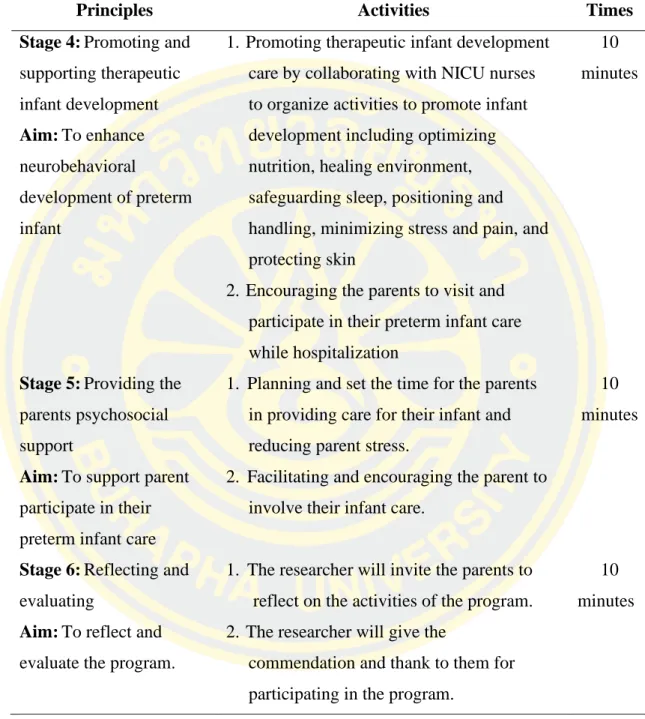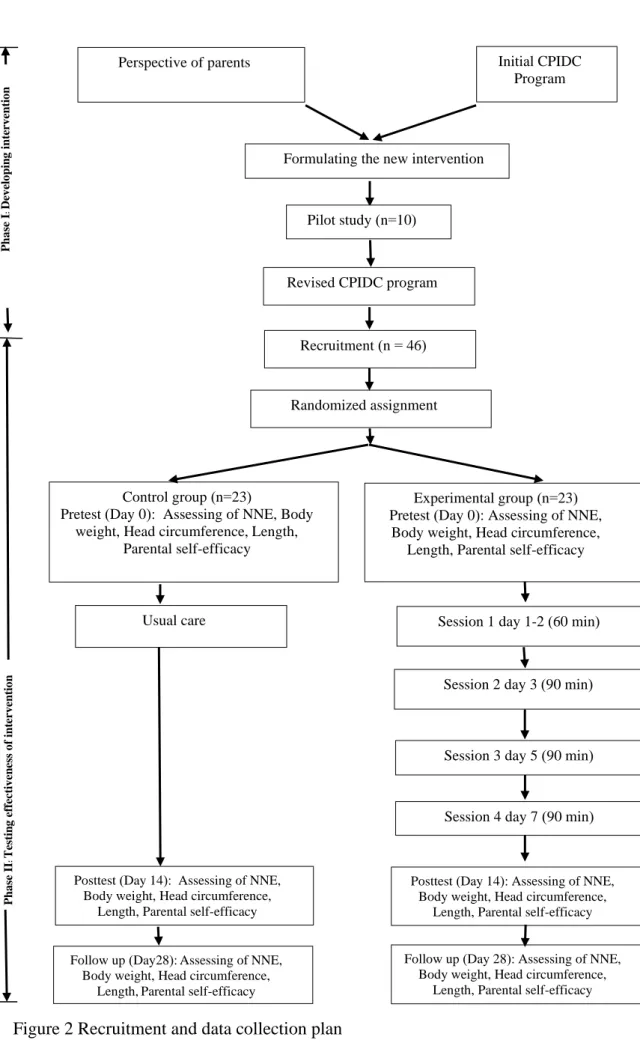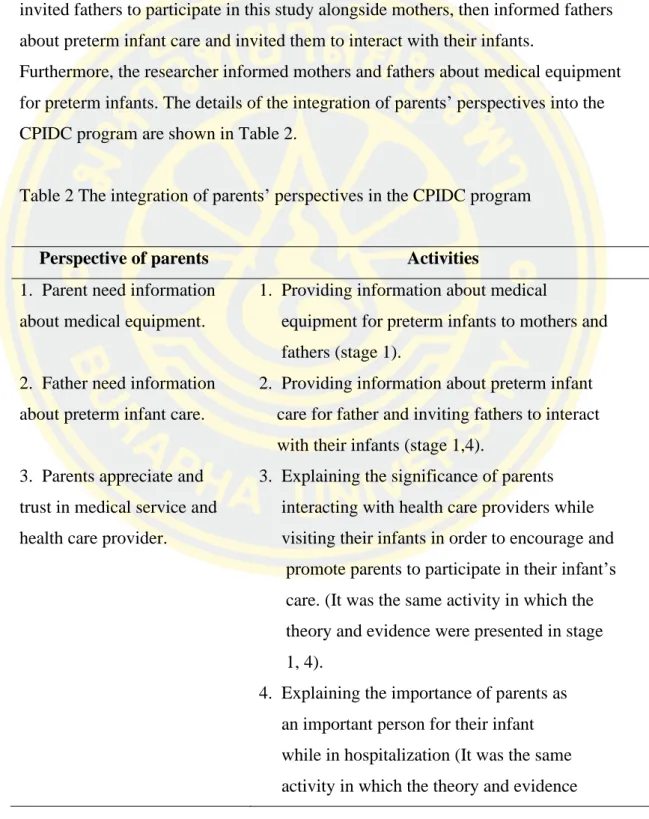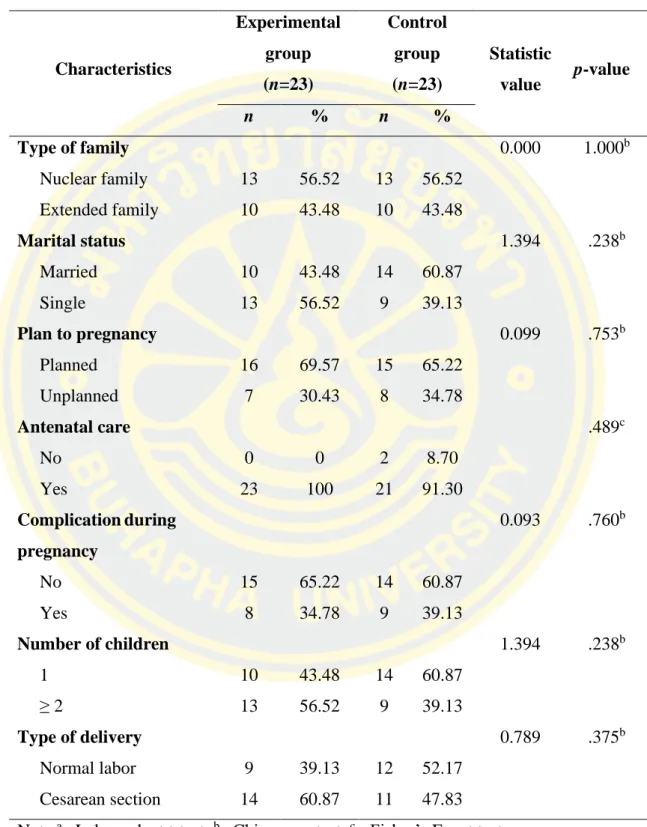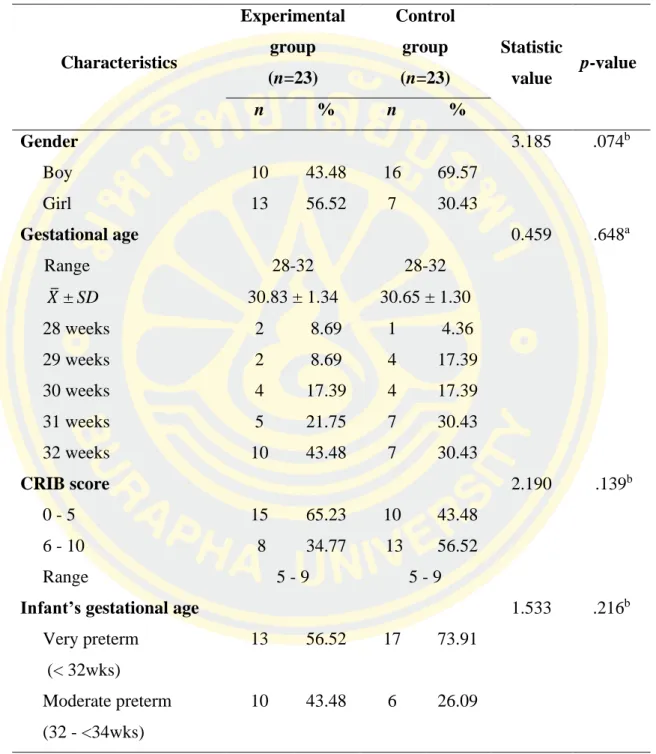112 Table 13 Simple effect of time on weight gain scores in the experimental and control groups (within subjects simple effects). 132 Table 31 Simple effect of time on parental self-efficacy scores in the experimental and control groups (within subjects, simple effects).
INTRODUCTION
Protein accumulation and a lack of energy are observed in preterm infants in the NICU during their hospitalization (Mariani et al., 2018). Setting goals for the developmental care of preterm infants. Phase 2: Understanding the context of the parents and premature babies.
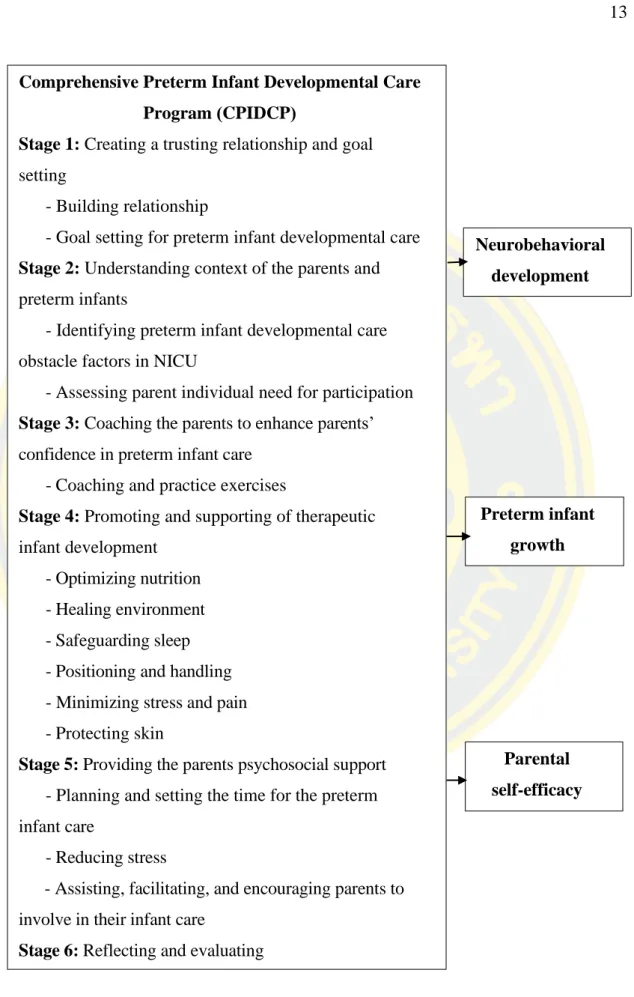
LITERATURE REVIEWS
This is the rate at which preterm infants regain their birth weight (Ehrenkranz et al., 2011). In addition, supporting parents to understand the behavior of premature infants can promote parental trust (Larocque et al., 2015).
RESEARCH METHODOLOGY
The objective of this phase was to increase parents' knowledge and self-efficacy in caring for premature infants. In addition, the parents were allowed to visit and participate in the care of the premature baby. The objective of this phase was to support parents in their participation in the care of premature infants.
The researcher guided the objective for the parents based on the reality of the parents' participation in premature infant developmental care. The parents were encouraged to express their feelings about the situation of their premature infant. The researchers guided the goal setting for the parents based on the reality of parental participation in premature infant developmental care.
The intervention focuses on training parents to develop their self-efficacy in caring for preterm infants, promoting and supporting infant therapeutic development, providing parent psychosocial support, and reflection and evaluation (stages 3-6). The researchers provided educational training including sleep conservation, positioning, and handling consisting of 1) preterm infant sleep stages and 2) preterm infant positioning and handling. The researcher also planned and scheduled the time for the parents to care for their premature baby and reduce the parents. The researcher also planned and scheduled the time for parents to care for their premature baby and reduce parental stress.
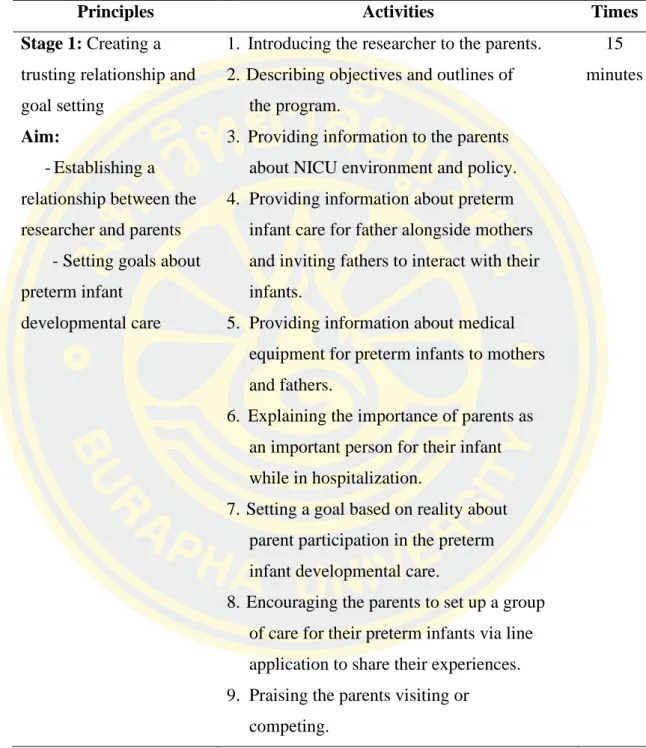
RESULTS
Development of CPIDC program
Perspectives of parents towards participation in preterm infant
Formulating the new intervention
The new intervention, the CPIDC program was then developed based on the integration of related theoretical, scientific knowledge and research evidence. The collected perspectives of parents were also integrated in the formulation of the VPIDC programme.
Pilot study the CPIDC program
The interviewed data were collected for analysis of the current situation of parental participation in developmental care for preterm infants during hospitalization. It can also be used to monitor or verify that the parents are visiting their preterm baby and participating in the care of the preterm baby. At this stage, the parents were encouraged to express their feelings about their preterm baby's situation.
The researchers encouraged parents to identify and assess their individual needs for involvement in their premature infants' care during hospitalization. To help the parent to understand their feeling, participation in premature care, premature infant signals and their. Encouraging parents to identify and assess their individual needs for involvement in their premature care during hospitalization.
Parental Desire: Parents preferred to participate as much as possible in their premature developmental care. Discussion of the obstacles of participating in the care of premature babies during NICU hospitalization (This was the same activity in which the theory and evidence were presented in stage 2). Encouraging the parents to identify and assess their individual need for involvement in their premature baby care during.
Verification the CPIDC program on preterm infant growth, preterm infant
The CONSORT flow diagram
They were all willing to participate in the research project and had not refused to participate. Forty-six participants were randomly assigned to the experimental group (23 cases) and the control group (23 cases). There was no dropout rate among experimental group participants during the post-intervention and follow-up period.
There was no dropout rate among participants in the control group during the post-intervention and follow-up periods as well. Consequently, the results were analyzed in an experimental group of 23 participants and a control group of 23 participants, as shown in Figure 3.
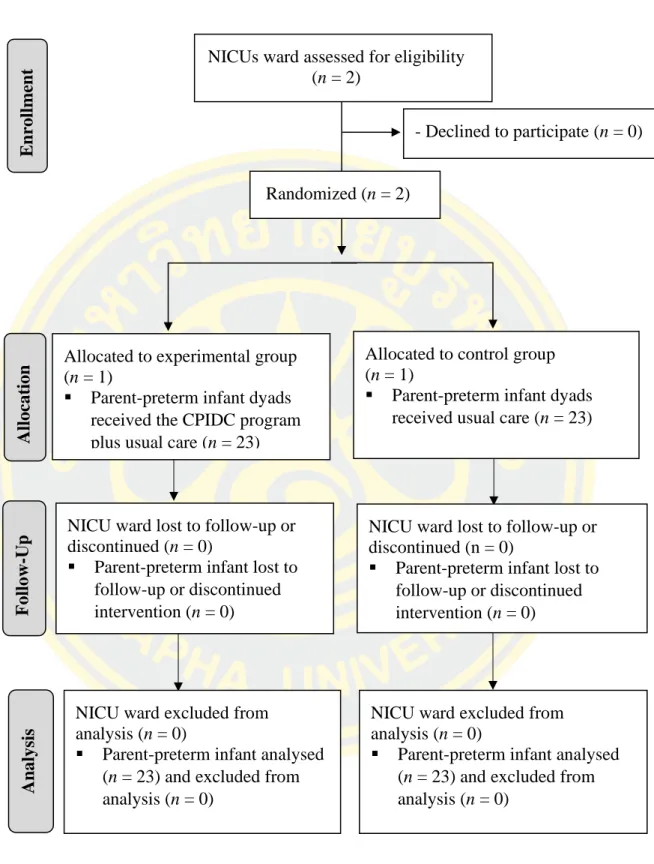
Characteristics of participants in the experimental and control groups
Parental characteristics between the experimental and control groups were compared using the chi-square test and Fisher's exact test for categorical data and the t test for continuous data to determine their differences. Characteristics of preterm infants between the experimental and control groups were compared using the chi-square test and Fisher's exact test for. There were no statistically significant differences in the characteristics of preterm infants between the experimental and control groups (p> 0.05), the details of which were shown in Table 5.
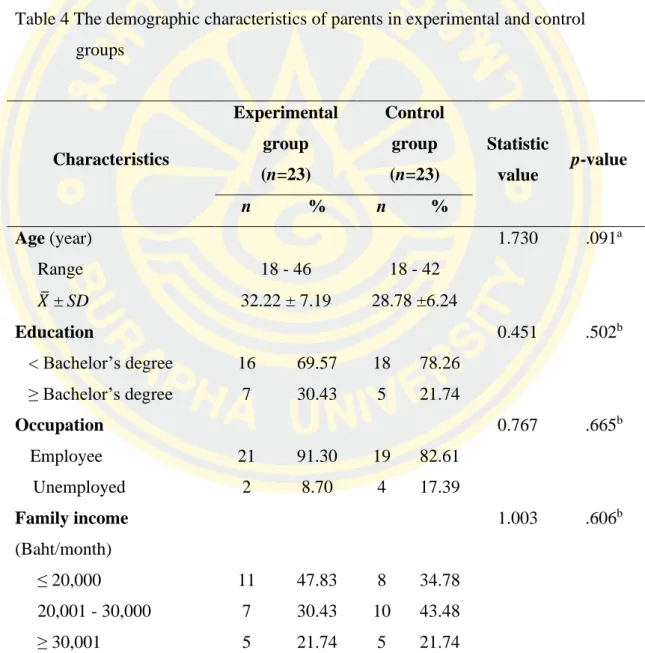
Descriptive statistics of outcome variables
The results showed that the body weight, length and head circumference of the premature baby of both groups increased over time, as shown in Table 6. The results showed the average results of the weight gain of the premature baby, the increase in length and circumference of scalp in the experimental group were higher than in the control group at three time periods. However, it was also found that the mean scores of preterm infants' weight gain, height growth and head circumference growth of the experimental and control groups showed an increasing trend over time, as presented in Table 7.
This section describes the mean scores and standard deviations of neurobehavioral development of preterm infants between three times measured in the experimental and control groups. It showed that the neurobehavioral development of preterm infants of both groups was increasing over time, as presented in Table 8. This section describes the mean scores and standard deviations of parental self-efficacy among the three times measured in the experimental groups and control ones.
It showed that the parents' self-efficacy for both groups increased over time, as shown in table 9.
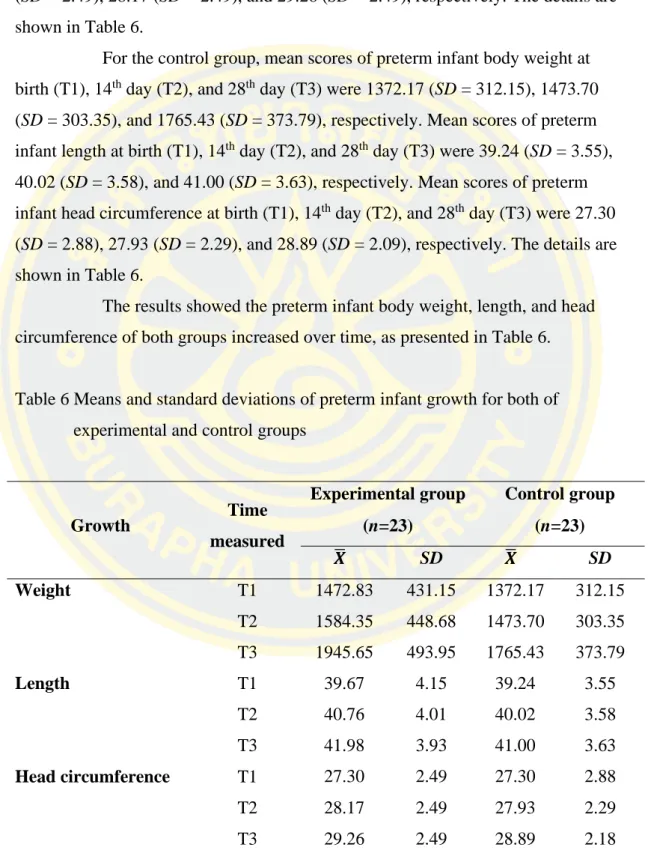
Comparison of pre-intervention scores of outcome variables between
Examine the effectiveness of the CPIDC program on preterm infant growth
The results showed that the main effect of the CPIDC program on the mean weight gain of premature infants was not statistically significant between the experimental and control groups (F p > 0.05, η2p = 0.076). As illustrated in the interaction plot in Figure 4, the mean scores for weight gain in the experimental and control groups showed a trend towards. The results showed that the main effect of the CPIDC program on the mean gain of the head circumference of premature infants was a statistically significant one between the experimental and control group ((F p < 0.05, η2p = 0.122).
As illustrated in the interaction plot in Figure 5, the mean scores for head circumference increase in the experimental and control groups showed a trend toward increasing overtime. The results showed that the main effect of the CPIDC program on mean length increase was statistically significant between the experimental and control groups (F p < 0.01, η2p = 0.157). As illustrated in the interaction plot in Figure 6, the mean length gain scores for the experimental and control groups showed a trend toward .
An independent t-test was used to examine the difference in the mean scores of the rate of weight gain between experimental and control groups on the 14th day, the 28th day from birth and the 28th day from day 14. The results showed that the main effect of the CPIDC Program for the mean neurobehavioural development score of preterm infants was statistically significant between the experimental and control groups (F p < .001, η2p = .269). As illustrated in the interaction diagram in Figure 7, the mean neurobehavioral development scores of the experimental and control groups trended toward increasing overtime.
The results showed that the main effect of the CPIDC program on the mean parental self-efficacy score was statistically significant between the experimental and control groups (F p < .05, η2p = .121). As illustrated in the interaction plot in Figure 8 , mean parenting self-efficacy scores in the experimental and control groups increased significantly over time.
CONCLUSION AND DISCUSSION
Premature infants who received the CPIDC program had significantly higher mean scores of neurobehavioral development than those who received usual care at post-intervention (on day 14 from birth: T2) and follow-up (on day 28 from birth: T3) . The preterm infants who received the CPIDC program had significantly higher mean scores of preterm infant height gain than those who received the usual care on the 14th day from birth (T1) and on the 28th day from birth (T3). The preterm infants in the CPIDC program had significantly higher mean scores of preterm infants weight gain than those who received the usual care on the 28th day from the 14th day (T2).
The preterm infants who received the CPIDC program on day 28 from birth (T2) and on day 28 from birth (T3) had significantly higher mean preterm infant weight gain scores than those on day 14 from the birth (T1) . However, the preterm infants who received the CPIDC program as early as day 28 from birth (T3) had significantly higher mean scores for preterm infant length gain and head circumference gain than those on day 28 from day 14 (T2) and at 14th day from birth (T1). Furthermore, the preterm infants who received the CPIDC program only at day 28 from birth (T3) had significantly higher mean scores for preterm infant length and head circumference than those at day 28 from day 14 (T2) and at on the 14th day from birth (T1).
These findings were consistent with a study of the effects of early-stage neurodevelopmental treatment on the growth of premature infants in the neonatal intensive care unit. The CPIDC program encouraged parents to visit their premature babies in hospital and participate in their infant care. The researcher encouraged parents to visit their premature babies in the hospital and participate in their care.
The mothers gained confidence and were able to care for their premature babies after participating in the CPIDC program. Effects of the parental sensitivity intervention in mothers and fathers of preterm infants: a quasi-experimental study.
